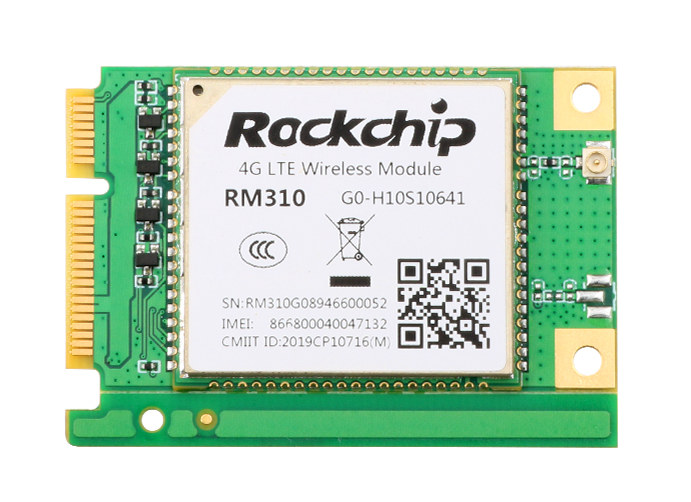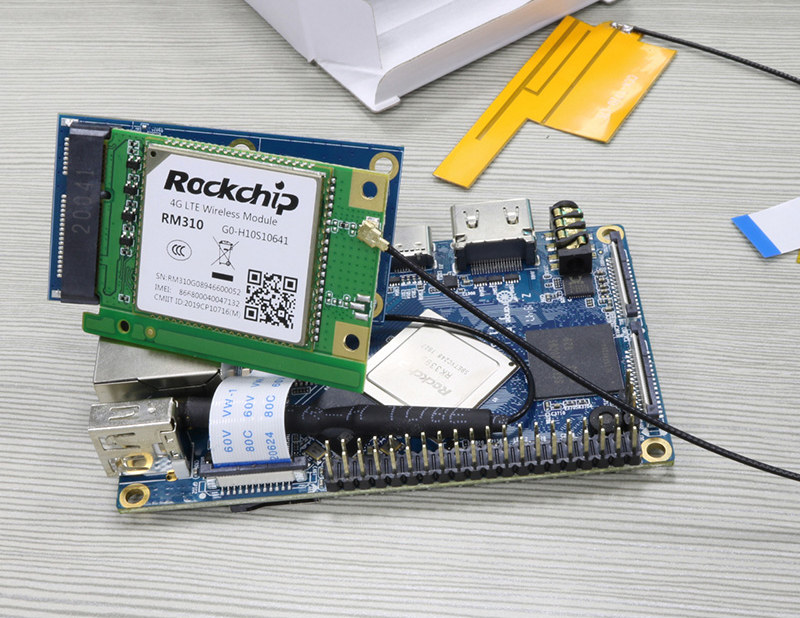Orange Pi 4 SBC is one of the most cost-effective Rockchip RK3399 SBC’s, as it sells for as low as $50 with 4GB RAM, Gigabit Ethernet, WiFi, and Bluetooth, HDMI 2.0 output, etc..
The board also comes with a 24-pin PCIe connector that’s not of much use on its own, so the company introduced a $4 PCIe adapter board providing access to a standard mPCIe socket and a SIM card slot so you could install your own. 4G mini PCIe cards can easily cost around $50 or more, but Shenzhen Xunlong Software has now launched its own 4G LTE mini PCIe card based on Rockchip RM310 module and sold for $16 on Aliexpress, excluding shipping.
 mPCIe card and RM310 module specifications:
mPCIe card and RM310 module specifications:
- Frequency bands
- LTE-FDD – B1, B3, B5, B8
- LTE-TDD – B38, B39, B40, B41
- WCDMA – B1, B5, B8
- GSM – 850, 900, 1800, and 1900 MHz
- Data rates
- 4G LTE – 150 Mbps DL, 50 Mbps UL
- 3G WCDMA – 42 Mbps DL, 5.76 Mbps UL
- GSM / EDGE – 86.6 Kbps DL and UL
- Bandwidth – 1.4, 3, 5, 10, 15, 20 MHz
- Antenna – DL MIMO with Rx diversity support
- Host Interface – mPCIE socket with USB 2.0 signals
- Supply Voltage – 3.3V to 4.3V (typ. 3.8V)
- Temperature Range – -40 to +85°C
- Dimensions
- RM310 module – 32 x 29 x 2.6mm
- mPCIe card – ~51 x 36 mm (estimated)
Remember you’ll need the PCIe adapter board as well to connect the mini PCIe card. Also, make sure to check the frequency bands are supported in your country/operator using sites such as Frequency Check. The back of the board has silkscreen reading “Rockchip RM310MINIPCIE_V01 2019-07-30GX”, so it might just be a product out of Rockchip instead of a card designed by Shenzhen Xunlong Software. But at this point, I can’t find any other RM310 cards.
Sometimes hardware is launched without software support, but RM310 LTE module support was enabled in Rockchip Linux in March 2020, so hopefully, it’s working well out of the box as long as you run a recent kernel. That also means it should work with any Rockchip RK3399 board or product with a compatible mini PCIe socket. Note that the card may be slightly out of specs mechanically speaking, as mPCIe cards should not be larger than 30 x 51 x 6mm in size.

Jean-Luc started CNX Software in 2010 as a part-time endeavor, before quitting his job as a software engineering manager, and starting to write daily news, and reviews full time later in 2011.
Support CNX Software! Donate via cryptocurrencies, become a Patron on Patreon, or purchase goods on Amazon or Aliexpress. We also use affiliate links in articles to earn commissions if you make a purchase after clicking on those links.






> hopefully, it’s working well out of the box as long as you run a recent kernel.
I would believe it’s quite the opposite since while this piece of hardware being just an USB modem it seems it requires a special driver for power/reset: https://github.com/rockchip-linux/kernel/commit/1bf79945c5657f4b0526f914af0dc7b512a0f42e
So unless someone submits this to mainline the USB card might only work using Rockchip’s ancient 4.4 kernel?
I should have written “recent Linux 4.4 kernel from Rockchip Linux repo…”
After you get done with US patent extortion fees, that $12 LTE modem will probably cost $75 for the US version.
Sure you can order it off from Aliexpress for $16 right now. But that is not the same thing as importing 200,000 for resale. If you tried to resell 200,000 in the US you can bet that Qualcomm et al will show up and demand their payments. Anyway, this model is the wrong bands for US. It will probably work on AT&T but coverage will be limited due to it not having all of the needed bands.
Also I am exaggerating because the ‘license’ payments annoy me. Similar PCI cards with US bands are about $40 including the patent fees.
Doe not support band 20 so it only work in good coverage areas
Doesn’t the patent thing work worldwide?
Patents are separate in each country. Large companies will often file the same patent in all of the major countries, but it is not a given that they will be approved everywhere. The reason why you hear about Chinese companies licensing US patents is so that they can sell into the US market. Many aspects of cellular technology are patented (usually by Qualcomm) inside the US are not patented in the rest of the world. The US cell standards also contain patented technology that does not apply to other countries like how 911 is handled. Google around for an iPhone cost break down. $1000 phones in the US are paying around $150/phone in patent licenses.
This is never going to go away because the same group of companies are sticking all of their patented solutions into the 5G standards. That is a very annoying thing since many times there are free options which are just as good. But the people writing the standards are the ones that own the patents, so of course all of their patented technology ends up in the standards.
The patent barrier around the US is so strong that it keeps Xiaomi from entering the US phone market. If Xiaomi enters they will use a Qualcomm CPU instead of Mediatek to avoid a patent fight. Of course the US versions of their phone will cost a lot more.
Not that I like the patent system but this seems like entirely the point of it.
It’s not great spending millions developing and standardising something only for some fabless company in China to re-implement it after you’ve done the R&D and then flood your home market with clones that don’t have to sink any of the development costs.
Qualcomm collects about $6 billion a year in licensing fees and they’ve been doing similar to that for the last 20 years. Who gave Qualcomm and their buddy Verizon the right to make US cell phones and cell service cost double what they cost in the rest of the world? US is the largest cell phone and service market in the world, yet it has the highest prices of the developed nations.
A very fundamental problem with cellular standards is that they are written by the people who own all of the patents. And funny how that turns out, every time there is a choice between a free option and a patented one, guess which one gets picked? Maybe the Qualcomm stuff is a couple of percent better. But we are denied the ability to choose a phone that is 98% as good and half the price. This problem is pretty bad when the third largest phone manufacturer in the world won’t enter the US market.
So you support Chinese IP Theft. You are the annoyance here.
How does the Orange Pi 4 compare to other RK3399 SBCs these days, especially the Rock Pi 4 (which seems to be sold out in most places)? Readily-available information on things like the number of external connectors, USB ports, etc. aside.
Att bands 2,4,17,30. Please! I want a rk3399 SBC, that Texts and phones, and used carrier data links